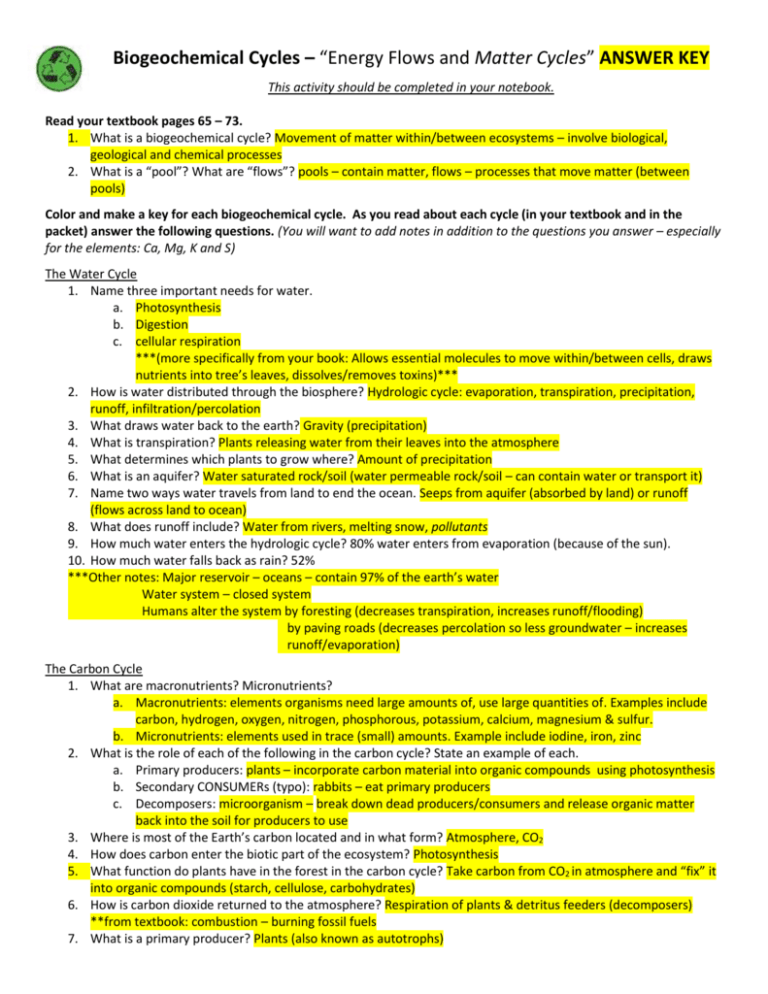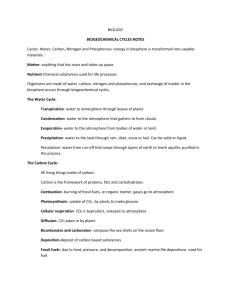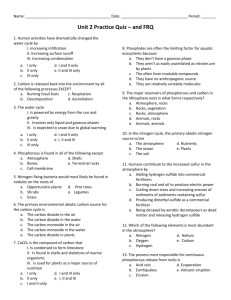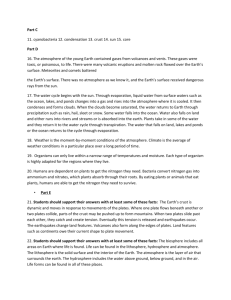Biogeochemical Cycles Packet - ANSWER KEY
advertisement

Biogeochemical Cycles – “Energy Flows and Matter Cycles” ANSWER KEY This activity should be completed in your notebook. Read your textbook pages 65 – 73. 1. What is a biogeochemical cycle? Movement of matter within/between ecosystems – involve biological, geological and chemical processes 2. What is a “pool”? What are “flows”? pools – contain matter, flows – processes that move matter (between pools) Color and make a key for each biogeochemical cycle. As you read about each cycle (in your textbook and in the packet) answer the following questions. (You will want to add notes in addition to the questions you answer – especially for the elements: Ca, Mg, K and S) The Water Cycle 1. Name three important needs for water. a. Photosynthesis b. Digestion c. cellular respiration ***(more specifically from your book: Allows essential molecules to move within/between cells, draws nutrients into tree’s leaves, dissolves/removes toxins)*** 2. How is water distributed through the biosphere? Hydrologic cycle: evaporation, transpiration, precipitation, runoff, infiltration/percolation 3. What draws water back to the earth? Gravity (precipitation) 4. What is transpiration? Plants releasing water from their leaves into the atmosphere 5. What determines which plants to grow where? Amount of precipitation 6. What is an aquifer? Water saturated rock/soil (water permeable rock/soil – can contain water or transport it) 7. Name two ways water travels from land to end the ocean. Seeps from aquifer (absorbed by land) or runoff (flows across land to ocean) 8. What does runoff include? Water from rivers, melting snow, pollutants 9. How much water enters the hydrologic cycle? 80% water enters from evaporation (because of the sun). 10. How much water falls back as rain? 52% ***Other notes: Major reservoir – oceans – contain 97% of the earth’s water Water system – closed system Humans alter the system by foresting (decreases transpiration, increases runoff/flooding) by paving roads (decreases percolation so less groundwater – increases runoff/evaporation) The Carbon Cycle 1. What are macronutrients? Micronutrients? a. Macronutrients: elements organisms need large amounts of, use large quantities of. Examples include carbon, hydrogen, oxygen, nitrogen, phosphorous, potassium, calcium, magnesium & sulfur. b. Micronutrients: elements used in trace (small) amounts. Example include iodine, iron, zinc 2. What is the role of each of the following in the carbon cycle? State an example of each. a. Primary producers: plants – incorporate carbon material into organic compounds using photosynthesis b. Secondary CONSUMERs (typo): rabbits – eat primary producers c. Decomposers: microorganism – break down dead producers/consumers and release organic matter back into the soil for producers to use 3. Where is most of the Earth’s carbon located and in what form? Atmosphere, CO2 4. How does carbon enter the biotic part of the ecosystem? Photosynthesis 5. What function do plants have in the forest in the carbon cycle? Take carbon from CO2 in atmosphere and “fix” it into organic compounds (starch, cellulose, carbohydrates) 6. How is carbon dioxide returned to the atmosphere? Respiration of plants & detritus feeders (decomposers) **from textbook: combustion – burning fossil fuels 7. What is a primary producer? Plants (also known as autotrophs) 8. What happens when primary and secondary consumers die? Bodies are broken down detritus feeders, organic matter returned to soil/atmosphere 9. What do detritus feeders contribute to the carbon cycle? Return carbon to the soil and atmosphere 10. What is a fossil fuel? Used to generate energy; examples are coal, oil, natural gas 11. How does carbon get in the oceans? CO2 from atmosphere dissolves/diffuses into ocean ** CO2 in ocean combines with calcium in water to form CaCO3 – makes up shells of sea creatures, shells decay and turn into limestone, limestone dissolves in water and releases carbon back to atmosphere The Nitrogen Cycle 1. What percent of the air is nitrogen? 78% 2. Why is nitrogen essential to life? Used to form amino acids (proteins), nucleic acids (DNA/RNA), and ATP (energy currency of the cell) 3. How do plants and animals get nitrogen if not from the atmosphere? CANNOT use N2 (atmospheric nitrogen). Has to be “fixed” into a usable form (ammonia NH3). 4. What are nitrogen fixing bacteria? Convert nitrogen in the soil to NH3 so plants can take it up from the soil to use 5. What is a major reservoir for ammonia? The soil 6. Why do herbivores need nitrogen? Same reason as everything is – amino acids and nucleic acids 7. What is denitrification? Microorganisms in the soil break down the nitrates to nitrogen and it’s released back into the atmosphere The Phosphorous Cycle 1. Why is phosphorous an important biological molecule? Makes up ATP (used in photosynthesis), nucleic acids, and cell membranes 2. What happens to phosphorous that erodes from rock and soil? Water washes over rock and dissolves P and washes into rivers/streams. Forms phosphate with oxygen 3. How are phosphates incorporated into the organic molecules in plants and animals? Phosphates in water are absorbed by plants, also enter soil where they are absorbed. Animals eat the plants. 4. What happens to the phosphates when plants and animals die? Plant/animal waste 5. What happens to the phosphorous that is carried by runoff to the oceans? Concentrated in marine sediment and is incorporated into bodies of fish 6. How are phosphates incorporated into the organic molecules in aquatic plants and animals? incorporated into bodies of fish 7. What is different about the phosphorous cycle as compared to the water, carbon and nitrogen cycles? No atmospheric phosphorous *** from textbook: Phosphorous is a limiting nutrient in aquatic systems because most precipitates out of the water (forms solid because insoluble) and doesn’t stay dissolved in the water Notes on Ca, Mg, K and S:








